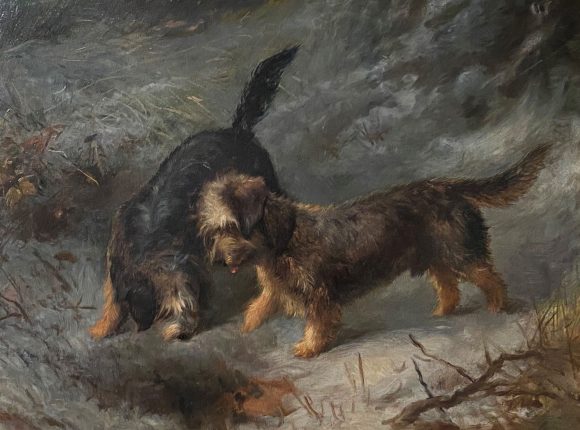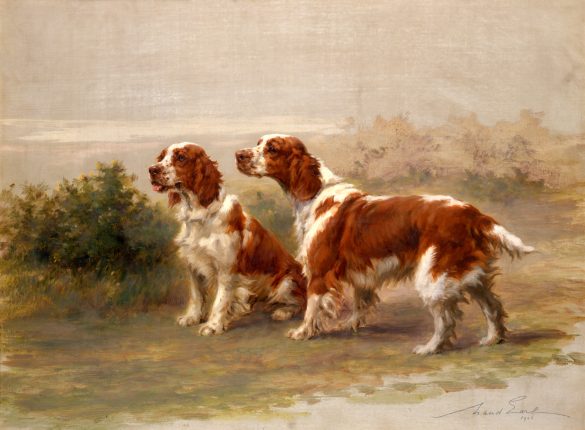The Kennel Club’s exhibition showcasing canine portraits by the Earl family is a celebration of dogs, art and history, writes Janet Menzies
FROM the 1850s to the present day, four generations of the Earl family, over more than 150 years, have been painting what it is that makes us tick. Now the Kennel Club has put together the first exhibition to span the whole family, not just in artwork but including letters, photographs and memorabilia of a family tree that grew its history across the continents.
So what does define our passions at home and overseas? Those in tears at the late Queen Elizabeth II’s funeral procession know very well that dogs and horses are integral to our lives. And then there is our love of exploration and adventure, and the way we share this with all those we meet. The two brothers who founded the Earl painting dynasty, Thomas William Earl and his younger brother George, were dog lovers. Thomas became known for his portraits of individual dogs, especially characterful terriers with scruffy coats.

George went a step further by putting his dogs – mainly gundogs – into grand narrative works. He became a member of the Kennel Club in the 1870s at about the same time as he painted The Field Trial. This panoramic sweep of the Welsh mountains at Bala is crammed with field-trialling faces of the day and their dogs, all of whom would have recognised themselves and their friends. It was probably this painting that inspired the commission from Sir Andrew Barclay of the Walker Brewery, founder of Liverpool’s Walker Art Gallery, to paint the two railway scenes, Going North and Coming South. The paintings disappeared for many years before George Earl’s final versions were found in a sorry state in a Walker Brewery pub, The Vines, near Liverpool Lime Street station, and now hang in the National Railway Museum.
At a time when Victorian narrative painting could be over-sentimental, George Earl’s depiction is loved because it tells the truth. Amid the platform chaos, it is obvious that things will be forgotten; too much will be taken; the dogs will be a nuisance; tempers will fray, just as they do today. For the whole Earl family, context was just as important as the portrait of a particular animal. Kennel Club art collection curator Marianne Walker says: “Paintings by the Earl family have long been praised by critics for their ability to capture the unique characters of society’s much-loved canine companions. Personally, I love the fact that George Earl was a trailblazer in that he led the fashion in painting named dogs, particularly in his series entitled ‘Champion Dogs of England’. This means we not only know what the dogs looked like but their histories and who they belonged to, which is invaluable for our archive.”

Luisa Foster, also art collection curator at the Kennel Club, points out: “I like that George Earl encouraged his children to study art. Maud and her half-brother Thomas Percy were encouraged to practise their artistic skills and George’s involvement in the sporting and dog worlds ensured that animals played an important part in their studies.” While Maud continued the family tradition of canine portraits, Thomas Percy concentrated on equines, mainly the famous racehorses of the 1920s and 1930s. The Kennel Club exhibition includes his painting, King George V with his granddaughters, Princesses Elizabeth and Margaret Rose, from about 1935, lent by the Royal Collection.
Into the next generation, the Earl family was still at the heart of our social and cultural life. A decade after Thomas Percy’s royal painting, his nephew Jack Earl, who had emigrated to Australia, was at Sydney Harbour about to embark on a circumnavigation in his yacht, Kathleen, named after his wife. Already an established maritime artist, Jack painted pictures during the 18-month voyage to pay for supplies. Kathleen and the children had originally planned to accompany Jack, but this proved impractical, so Jack created 12 elaborately illustrated logbooks, which were sent on to the family whenever the Kathleen reached port. These must have inspired Jack’s daughter, Maris, in her art, which a 1995 Sydney Morning Herald article described as full of sincerity and feeling.

From that hissing steam train waiting on the platform of a Victorian King’s Cross station, to sailing round the world, the work of the Earl family continues to speak to us. For the Kennel Club, this has been most importantly through their love of dogs. Foster concludes: “The Earl family are one of the most renowned families to portray the dog in art during the 19th and early 20th centuries, so it is a natural fit for the Kennel Club Art Gallery. This exhibition is the largest compilation of works from the family displayed together in history and is a real celebration of dogs, art and history.”




